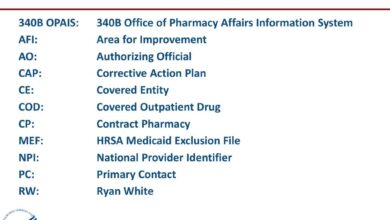
Revenue Cycle Management R1 RCM Acquisition
Revenue cycle management R1 RCM acquisition is shaking up the healthcare industry! This isn’t just another corporate merger; it’s a major shift in how healthcare providers manage their finances. We’re diving deep into the strategic moves, financial implications, technological integrations, and the overall impact on both R1 and the healthcare providers they serve. Get ready for a fascinating look into the complexities and opportunities presented by this significant acquisition.
This post will unpack the current state of the RCM market, analyze R1’s acquisition strategy, explore the financial and technological aspects of these deals, and examine their impact on healthcare providers and the regulatory landscape. We’ll also look at future trends and what this all means for the future of healthcare revenue management. Buckle up, it’s going to be a ride!
Revenue Cycle Management (RCM) Market Overview
The Revenue Cycle Management (RCM) market is experiencing significant transformation, driven by technological advancements, evolving regulatory landscapes, and a growing need for healthcare providers to optimize their financial performance. This dynamic environment presents both opportunities and challenges for healthcare organizations and the vendors that serve them.
Current State of the RCM Market and Key Trends
The RCM market is characterized by increasing adoption of cloud-based solutions, the integration of artificial intelligence (AI) and machine learning (ML) for automation and predictive analytics, and a heightened focus on data security and compliance. Key challenges include the complexity of healthcare billing and coding, the rising costs of healthcare, and the need for improved interoperability between different healthcare systems.
The shift towards value-based care is also impacting RCM, requiring providers to focus on outcomes and efficiency rather than just volume. Furthermore, the increasing prevalence of telehealth is creating new opportunities and challenges for RCM, requiring solutions that can effectively manage the unique billing and reimbursement processes associated with virtual care.
Major Players in the RCM Market
Several major players dominate the RCM market, each offering a range of services and solutions. While precise market share data is often proprietary, some of the key players include companies like R1 RCM, Optum, and Atos. These companies offer comprehensive RCM solutions, including billing, coding, claims processing, and revenue analytics. Smaller, niche players also exist, often specializing in specific areas like medical billing or practice management.
The competitive landscape is dynamic, with mergers, acquisitions, and the development of new technologies constantly reshaping the market. For example, the recent acquisition of [Insert Example of a recent RCM acquisition if known] demonstrates the ongoing consolidation within the industry.
Factors Driving Growth in the RCM Market
Several factors are contributing to the growth of the RCM market. The increasing volume of healthcare data, coupled with the need for efficient and accurate revenue cycle management, is driving demand for advanced technological solutions. The rising adoption of electronic health records (EHRs) is creating opportunities for integration with RCM systems, streamlining workflows and improving data accuracy. Furthermore, the growing focus on improving patient satisfaction and reducing administrative burden is leading healthcare providers to invest in RCM solutions that can automate tasks and improve communication with patients.
Government regulations and compliance requirements also contribute to the market’s growth, as providers need to ensure their billing and coding practices are compliant with various regulations.
Comparison of RCM Software Solutions
The following table provides a simplified comparison of some RCM software solutions. Note that features and pricing can vary significantly based on the specific needs of the healthcare organization and the chosen vendor. This table is for illustrative purposes and does not represent an exhaustive list of all available solutions.
| Software Solution | Key Features | Pricing Model | Target Market |
|---|---|---|---|
| Example Software A | Cloud-based, AI-powered claims processing, patient portal integration, robust reporting | Subscription-based, tiered pricing | Large hospital systems |
| Example Software B | On-premise and cloud options, focus on medical billing and coding, strong compliance features | Per-claim or subscription | Small to medium-sized practices |
| Example Software C | Comprehensive RCM suite, integrated with EHR systems, advanced analytics dashboard | Customizable subscription plans | Large physician groups and health systems |
| Example Software D | Specializes in revenue cycle analytics and reporting, integrates with various RCM systems | Per-user or per-module pricing | Healthcare organizations seeking advanced analytics |
R1 RCM Acquisition Landscape

Source: pmaworks.com
R1 RCM, a leading provider of revenue cycle management (RCM) solutions, has aggressively pursued an acquisition strategy to expand its market share and service offerings. This approach reflects a broader trend in the RCM industry, where consolidation is becoming increasingly common as providers seek to gain scale and enhance their technological capabilities. Understanding R1’s acquisition strategy is key to understanding its current market dominance and future potential.R1’s acquisitions haven’t been random; they’ve been strategically targeted to fill gaps in their service portfolio and expand their geographic reach.
The company typically looks for companies with complementary technologies, strong client bases, and a proven track record of success. This strategic focus allows for smoother integration and faster realization of synergies.
Strategic Rationale Behind R1’s Acquisitions
R1’s acquisitions are driven by several key strategic goals. These include expanding its service offerings to provide a more comprehensive suite of RCM solutions, enhancing its technological capabilities through the acquisition of innovative software and platforms, and broadening its geographic reach to serve a wider range of healthcare providers. Acquisitions also provide access to new client relationships, strengthening R1’s market position and creating cross-selling opportunities.
For example, acquiring a company specializing in a niche area like ambulatory surgery centers would immediately expand R1’s client base within that segment and allow them to offer a broader range of services to existing clients in other areas.
R1 RCM’s acquisition definitely shakes things up in revenue cycle management. The implications are huge, especially considering how the legal landscape is shifting; the Supreme Court’s recent decision, as reported in this article scotus overturns chevron doctrine healthcare , could significantly impact healthcare regulations and, consequently, how R1 RCM operates. This means we need to watch closely how these changes influence the future of healthcare revenue management.
Impact of Acquisitions on R1’s Market Position and Competitive Advantage
The cumulative effect of R1’s acquisitions has significantly strengthened its market position. By acquiring companies with specialized expertise and established client bases, R1 has expanded its service capabilities and broadened its reach across various healthcare sectors. This increased scale and comprehensive service portfolio provide a significant competitive advantage, allowing R1 to offer more comprehensive and integrated solutions than many of its competitors.
This translates to increased revenue and market share, further reinforcing their position as a leading player in the RCM market.
Comparison of R1’s Acquisition Strategy with Competitors
While many RCM companies employ acquisition strategies, R1’s approach stands out due to its focus on strategic alignment and seamless integration. Unlike some competitors who may acquire companies for purely financial reasons or to quickly expand into new markets without careful consideration of integration challenges, R1 prioritizes finding companies whose services and technologies complement their existing offerings. This allows for a more efficient integration process and quicker realization of synergies, resulting in a more effective and impactful acquisition strategy.
This contrasts with competitors who may experience challenges in integrating acquired companies, leading to integration costs and potential disruption to client services.
Financial Implications of RCM Acquisitions: Revenue Cycle Management R1 Rcm Acquisition
Analyzing the financial performance of R1 RCM following its acquisitions reveals a complex picture, influenced by both successful integrations and the inherent challenges of absorbing new companies and technologies. Understanding these financial implications is crucial for assessing the long-term viability and profitability of R1’s acquisition strategy. This section delves into the key financial metrics and models used to evaluate the success of these acquisitions.
R1’s Financial Performance Post-Acquisition
R1’s financial performance following acquisitions is typically assessed through a variety of key performance indicators (KPIs). These include revenue growth, operating margins, EBITDA (Earnings Before Interest, Taxes, Depreciation, and Amortization), and return on investment (ROI). While specific numbers vary depending on the acquired company and the integration timeline, a general trend can be observed. Successful acquisitions usually lead to an increase in revenue, though there may be short-term dips due to integration costs.
Operating margins can fluctuate during the integration period but should improve over time as synergies are realized. EBITDA provides a clearer picture of operational profitability, excluding the impact of financing and accounting choices. A positive ROI signifies a profitable acquisition, although the time horizon for realizing that ROI can vary significantly. Analyzing R1’s financial reports (10-K filings with the SEC) over the past few years provides a granular view of the post-acquisition performance of specific deals.
For example, a review of these reports might show a particular acquisition initially impacting margins negatively due to integration expenses, but leading to significant revenue growth within two years.
Key Financial Metrics in RCM Acquisitions
Several key financial metrics are instrumental in evaluating the financial health and success of RCM acquisitions. These metrics provide a framework for understanding the value creation and potential risks associated with such transactions.
- Return on Investment (ROI): This metric measures the profitability of an investment relative to its cost. A higher ROI indicates a more successful acquisition. Calculating ROI for an RCM acquisition involves comparing the net present value of future cash flows generated by the acquired company to the initial investment cost. For instance, an acquisition costing $100 million that generates $150 million in net present value over five years would have a 50% ROI.
- EBITDA Margin: This metric represents a company’s operating profitability, calculated as EBITDA divided by revenue. It is often used to compare the profitability of different RCM companies and track the impact of acquisitions on operating efficiency. A higher EBITDA margin indicates stronger operational performance.
- Revenue Growth: This metric reflects the increase in revenue generated by the acquired company, both organically and through synergies with R1. Consistent revenue growth post-acquisition is a positive indicator of successful integration and market expansion.
- Debt-to-Equity Ratio: This metric measures the proportion of a company’s financing that comes from debt versus equity. A higher ratio indicates higher financial risk. Acquisitions often increase debt levels, so monitoring this ratio is crucial for assessing the financial stability of R1 post-acquisition.
Financial Model for Future RCM Acquisitions
A simplified financial model for simulating the impact of future RCM acquisitions on R1’s financial statements could incorporate several key assumptions. These include the purchase price of the target company, the expected revenue synergies, the integration costs, and the discount rate used for calculating net present value. The model would then project the impact of the acquisition on R1’s revenue, EBITDA, net income, and other key financial metrics over a period of several years.
For example, a hypothetical acquisition of a smaller RCM provider could be modeled, estimating a 10% increase in revenue within the first year, offset by 5% of the purchase price in integration costs. The model would then project the incremental EBITDA and net income resulting from the acquisition, factoring in projected growth rates and cost savings. This model would need to be updated with each new acquisition and incorporate adjustments based on actual performance.
Key Financial Aspects of RCM Acquisitions
The financial aspects of RCM acquisitions are multifaceted and require careful consideration. Key elements include:
- Valuation of the target company: Accurately valuing the target company is crucial to ensure a fair purchase price. This involves analyzing the target’s financial performance, market position, and growth potential.
- Financing the acquisition: Securing adequate financing is essential. This might involve a combination of debt and equity financing, and the cost of financing will impact the overall ROI.
- Integration costs: Integrating the acquired company into R1’s operations can be expensive and time-consuming. These costs should be factored into the financial projections.
- Synergy realization: Identifying and realizing synergies between R1 and the acquired company is crucial for maximizing the value of the acquisition. Synergies can include cost savings, revenue growth, and improved market share.
- Post-acquisition performance monitoring: Regularly monitoring the financial performance of the acquired company post-acquisition is essential to ensure that the acquisition is meeting its objectives.
Technological Aspects of RCM Acquisitions

Source: webflow.com
The successful integration of acquired Revenue Cycle Management (RCM) companies hinges heavily on the seamless merging of their technological infrastructures. This involves not only the technical aspects of software integration but also the strategic leveraging of data analytics to optimize processes and improve revenue generation. A smooth transition requires careful planning, significant investment, and a deep understanding of both the acquired company’s and R1’s existing systems.
Software Integration in RCM Acquisitions
Software integration is a critical aspect of any RCM acquisition. This involves merging disparate systems, including patient management systems, billing systems, claims processing software, and reporting dashboards. The complexity of this process is directly proportional to the number of different systems and vendors involved. A phased approach, prioritizing essential systems first, is often the most effective strategy.
Challenges arise from data format inconsistencies, differing workflows, and the potential for data loss during migration. Successful integration often requires significant investment in custom coding and integration tools. For example, a hypothetical acquisition of a smaller RCM firm using a legacy billing system might necessitate the development of custom interfaces to connect it with R1’s more modern, cloud-based platform.
This might involve mapping data fields, creating custom ETL (Extract, Transform, Load) processes, and rigorous testing to ensure data accuracy and system stability.
Data Analytics in Post-Acquisition RCM Integration
The combined data from acquired RCM companies offers a wealth of opportunities for enhanced data analytics. By integrating data from multiple sources, R1 can gain a more comprehensive view of its client base, identify trends, and optimize revenue cycle processes. This includes improved forecasting of revenue streams, enhanced identification of potential denials, and better understanding of payer behavior. For example, post-acquisition analysis might reveal that a specific payer consistently denies claims due to a particular coding issue.
This insight can then be used to refine coding practices across the entire R1 system, leading to significant improvements in claim acceptance rates. The ability to perform such analyses requires not only the technical infrastructure to consolidate and process the data, but also the expertise to interpret the results and translate them into actionable strategies.
Technological Challenges in RCM Acquisitions
Several technological challenges can impede the successful integration of acquired RCM technologies. These include legacy system incompatibility, data security concerns, the need for extensive data migration, and the potential for system downtime during the integration process. Differences in data security protocols between the acquired company and R1 can also present significant hurdles, requiring careful planning and the implementation of robust security measures to protect sensitive patient data.
Furthermore, the sheer volume of data involved in an RCM acquisition can make data migration a complex and time-consuming process, requiring specialized tools and expertise. The risk of system downtime during integration is also a major concern, potentially impacting revenue and client satisfaction. Mitigation strategies include thorough planning, rigorous testing, and the implementation of robust backup and recovery systems.
RCM Technology Integration Flowchart
[Imagine a flowchart here. The flowchart would visually represent the following steps:
1. Assessment
Analyze existing R1 and acquired RCM systems, identify compatibility issues, and define integration goals.
2. Planning
Develop a detailed integration plan, including timelines, resource allocation, and risk mitigation strategies.
3. Data Migration
The recent R1 RCM acquisition is shaking up revenue cycle management, and a big part of that is addressing staffing challenges. A key issue is the persistent shortage of medical coders, which is impacting efficiency and revenue. Fortunately, there are innovative solutions emerging, like those described in this article on the ai powered solution to the medical coding worker shortage , which could significantly improve R1’s operational capabilities and ultimately boost their bottom line.
This makes the acquisition even more strategic in the long run.
Develop and execute a data migration plan, ensuring data accuracy and security.
4. System Integration
Integrate the acquired RCM systems with R1’s existing infrastructure.
5. Testing
Conduct thorough testing to ensure system functionality and data integrity.
6. Deployment
Deploy the integrated system and provide training to users.
7. Monitoring & Optimization
Continuously monitor system performance and optimize processes based on data analysis.]
Impact on Healthcare Providers
R1 RCM’s acquisition of other revenue cycle management companies significantly alters the landscape for healthcare providers. This impact reverberates through their operational processes, financial performance, and ultimately, the patient experience. Understanding these changes is crucial for providers navigating this evolving market.The acquisition of RCM companies by larger entities like R1 RCM streamlines and often improves healthcare providers’ revenue cycle processes.
R1 RCM’s acquisition in revenue cycle management is a big deal, impacting healthcare finances significantly. Understanding these financial complexities is crucial, much like understanding the health risks involved; for example, did you know that pre-existing conditions like high blood pressure are among the risk factors that make stroke more dangerous ? Just as managing those risks improves patient outcomes, efficient revenue cycle management improves the financial health of healthcare providers.
The acquisition could significantly impact how we address these financial challenges going forward.
Previously fragmented systems are consolidated, leading to potential efficiency gains. This can involve improved claims processing, reduced denials, and faster payment cycles. However, the integration process itself can be complex and disruptive, requiring significant investment in time, resources, and staff training.
Revenue Cycle Process Changes
RCM acquisitions can lead to a variety of changes in a healthcare provider’s revenue cycle. These include the implementation of new technologies, standardized workflows, and improved data analytics capabilities. For instance, a provider might see a shift from manual claim processing to automated systems, resulting in faster reimbursements and reduced administrative overhead. However, the transition may involve initial challenges such as system incompatibility issues and staff resistance to adopting new processes.
Successful implementation relies heavily on effective change management strategies and adequate staff training.
Benefits and Drawbacks of RCM Acquisitions for Healthcare Providers
Acquisitions offer potential benefits such as enhanced technology, improved efficiency, and reduced administrative costs. However, drawbacks include potential disruptions during integration, the need for significant upfront investment, and the risk of vendor lock-in. The ultimate success depends on careful planning, effective implementation, and a thorough understanding of the provider’s specific needs. A cost-benefit analysis should always be conducted before committing to any such acquisition-related changes.
Effect on Patient Experience and Satisfaction
Improved revenue cycle management can indirectly enhance patient experience. Faster billing processes, clearer communication regarding charges, and streamlined appointment scheduling can all contribute to higher patient satisfaction. Conversely, poor integration or system failures can lead to billing errors, delayed payments, and frustrated patients, potentially damaging the provider’s reputation. Therefore, a focus on patient-centric design and robust communication strategies during and after the acquisition is crucial.
Hypothetical Case Study: Community Hospital
Community Hospital, a mid-sized hospital struggling with high denial rates and slow payment cycles, partnered with R1 RCM following an acquisition of their previous RCM vendor. Prior to the integration, Community Hospital experienced a 15% denial rate and an average payment cycle of 60 days. After implementing R1 RCM’s technology and processes, they saw a reduction in denial rates to 5% and a decrease in the payment cycle to 35 days.
This resulted in a significant improvement in their cash flow and allowed them to reinvest in patient care services. However, the initial integration period was challenging, requiring staff retraining and temporary workflow adjustments. The hospital invested heavily in training and communication to mitigate the negative impact on both staff and patients during the transition. The long-term benefits, however, significantly outweighed the initial challenges.
Regulatory and Compliance Considerations
Acquiring a Revenue Cycle Management (RCM) company brings a complex web of regulatory and compliance issues. Navigating these successfully is crucial for a smooth transition and long-term success, avoiding hefty fines and reputational damage. The healthcare industry is heavily regulated, and RCM, being at the heart of healthcare finance, is no exception.The regulatory landscape surrounding RCM acquisitions is multifaceted, encompassing federal and state laws, as well as industry-specific guidelines.
Failure to address these considerations thoroughly can lead to significant legal and financial repercussions. Understanding these complexities is paramount for a successful acquisition.
HIPAA Compliance
The Health Insurance Portability and Accountability Act (HIPAA) is the cornerstone of healthcare data privacy and security. RCM acquisitions inherently involve the transfer of Protected Health Information (PHI), making HIPAA compliance a critical concern. Due diligence must include a thorough assessment of the target RCM company’s HIPAA compliance program, including its policies, procedures, and technological safeguards. Post-acquisition, the acquiring company must ensure the integration of the two systems maintains, and ideally improves, HIPAA compliance.
This involves reviewing and updating policies, conducting employee training, and implementing robust security measures to protect PHI throughout the entire revenue cycle. Failure to comply can result in significant fines and legal action.
Data Security and Privacy Regulations
Beyond HIPAA, various other regulations govern data security and privacy. These may include state-specific laws that offer even stricter protections than HIPAA, as well as international regulations if the acquired company operates globally. The acquiring company must conduct a comprehensive risk assessment to identify potential vulnerabilities and develop mitigation strategies. This assessment should cover all aspects of data handling, from storage and transmission to access control and incident response.
Regular security audits and penetration testing are essential to ensure ongoing compliance.
Antitrust Laws, Revenue cycle management r1 rcm acquisition
Mergers and acquisitions in the healthcare sector are subject to antitrust scrutiny. Regulatory bodies like the Federal Trade Commission (FTC) and the Department of Justice (DOJ) review acquisitions to ensure they don’t lead to reduced competition or anti-competitive practices. Acquiring companies must demonstrate that the acquisition won’t harm consumers through increased prices or reduced service quality. Thorough market analysis and a well-defined integration plan are crucial to demonstrate compliance with antitrust regulations.
State Licensing and Certification Requirements
RCM companies often require various state-level licenses and certifications to operate. The acquisition process must address the transfer of these licenses and ensure continued compliance with state-specific regulations. This can involve complex legal and administrative procedures, requiring careful planning and coordination with relevant state agencies.
Key Regulatory Bodies and Relevant Legislation
Understanding the key players and relevant legislation is crucial. A list of key regulatory bodies and legislation impacting RCM acquisitions includes:
- Federal Trade Commission (FTC): Enforces antitrust laws.
- Department of Justice (DOJ): Also enforces antitrust laws.
- Office for Civil Rights (OCR): Enforces HIPAA regulations.
- Centers for Medicare & Medicaid Services (CMS): Oversees Medicare and Medicaid billing and reimbursement.
- State licensing boards: Vary by state, but often oversee the licensing of healthcare providers and related businesses.
- Health Information Technology for Economic and Clinical Health Act (HITECH Act): Strengthens HIPAA regulations and expands enforcement authority.
Best Practices for Ensuring Compliance
Proactive measures are key to mitigating compliance risks. Best practices include:
- Conduct thorough due diligence: A comprehensive review of the target company’s compliance program is essential.
- Develop a comprehensive compliance plan: This plan should address all relevant regulations and incorporate robust internal controls.
- Implement robust data security measures: Protecting PHI is paramount, requiring strong security protocols and regular audits.
- Provide comprehensive employee training: Ensuring all employees understand and adhere to compliance requirements is crucial.
- Establish a compliance monitoring program: Regular monitoring and reporting mechanisms help identify and address potential issues promptly.
- Seek legal counsel: Consulting with experienced healthcare attorneys is highly recommended throughout the acquisition process.
Future Trends in RCM Acquisitions
The Revenue Cycle Management (RCM) sector is poised for significant transformation, driven by technological advancements, evolving regulatory landscapes, and the persistent need for healthcare providers to optimize their financial performance. Future acquisitions will likely reflect these forces, shaping the industry’s landscape in profound ways.The RCM acquisition market will witness continued consolidation, with larger players acquiring smaller firms to expand their market share and service offerings.
This trend is fueled by the increasing complexity of healthcare billing and the desire for providers to outsource these functions to specialized experts. Furthermore, the integration of advanced technologies will play a crucial role in shaping future acquisitions.
Impact of Emerging Technologies on RCM Acquisitions
Artificial intelligence (AI) and machine learning (ML) are rapidly changing the RCM landscape. AI-powered solutions can automate tasks such as claims processing, eligibility verification, and denial management, significantly improving efficiency and reducing costs. Acquisitions involving companies with strong AI/ML capabilities will be highly sought after, as these technologies offer a competitive edge in terms of speed, accuracy, and cost-effectiveness.
For example, an acquisition of a smaller RCM firm specializing in AI-driven predictive analytics could significantly enhance a larger firm’s ability to identify and mitigate potential revenue leakage. This strategic move would allow the acquiring company to offer more comprehensive and sophisticated services to its clients, justifying a premium price in the acquisition.
Further Consolidation in the RCM Market
The RCM market is already relatively consolidated, but further consolidation is expected. Larger RCM providers, often backed by private equity firms, possess the financial resources and strategic vision to acquire smaller competitors. This trend will lead to the emergence of even larger, more powerful RCM players capable of providing comprehensive, end-to-end solutions to healthcare providers of all sizes. We might see a pattern similar to what’s occurred in other healthcare sectors, where a handful of major players dominate the market.
This consolidation could lead to increased economies of scale, potentially resulting in lower prices for healthcare providers, but also potentially reduced competition and less choice.
Potential Future RCM Acquisition Scenarios
The following timeline illustrates potential future acquisition scenarios, acknowledging that precise predictions are inherently difficult:
| Year | Scenario | Description |
|---|---|---|
| 2024 | Increased AI-focused acquisitions | Larger RCM companies aggressively acquire smaller firms with advanced AI and ML capabilities for enhanced automation and predictive analytics. |
| 2025-2026 | Consolidation of niche players | Smaller, specialized RCM firms focusing on specific areas (e.g., dermatology, cardiology) are acquired by larger companies seeking to broaden their service offerings. |
| 2027-2028 | Strategic mergers and acquisitions | Larger RCM companies merge or acquire competitors to create even larger, more diversified entities with greater market reach and influence. This could involve both domestic and international acquisitions. |
This timeline reflects a plausible progression, acknowledging that unforeseen market shifts and technological breakthroughs could alter this trajectory. For example, the emergence of entirely new RCM technologies could disrupt the market and necessitate a reassessment of acquisition strategies.
Closing Summary
The R1 RCM acquisition story is a compelling example of strategic growth in a rapidly evolving market. The financial implications are significant, the technological integrations are complex, and the impact on healthcare providers is far-reaching. By understanding the intricacies of this acquisition, we can gain valuable insights into the future of revenue cycle management and the broader healthcare landscape.
The ongoing evolution of this sector promises further exciting developments and challenges in the years to come.
Questions Often Asked
What is R1 RCM?
R1 RCM is a leading provider of revenue cycle management services for healthcare organizations. They offer a range of solutions to help providers improve their financial performance.
Why is R1 acquiring other RCM companies?
Acquisitions allow R1 to expand their market share, gain access to new technologies and clients, and potentially increase profitability.
What are the risks associated with RCM acquisitions?
Risks include integration challenges, regulatory hurdles, and the potential for financial losses if the acquired company doesn’t perform as expected.
How do these acquisitions affect patients?
The impact on patients can vary, but ideally, improved RCM processes should lead to more efficient billing and reduced administrative burdens.
What are the long-term implications of this trend?
We may see further consolidation in the RCM market, with larger companies acquiring smaller ones to gain a competitive edge. This could lead to both benefits and challenges for healthcare providers.





